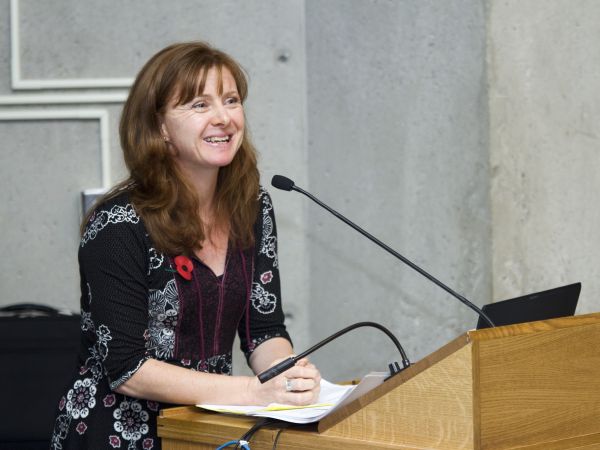A Damned Good Cry
How testimony is bringing the authentic survivor voice to Holocaust education in the United Kingdom
By Kay Andrews
For many of us working in the area of Holocaust education around the globe, one question has been raised repeatedly over the past years: How do we ensure that the survivor voice continues to be heard when individuals are no longer able to tell their stories? Here in the United Kingdom, there are a number of survivor speakers, but with more than 3,400 secondary schools (ages 11 to 18) in England alone, the actual number of students who will hear a survivor first-hand is limited. Thus, it is imperative to find innovative ways to bring survivor voices into the classroom. At the Institute of Education’s Centre for Holocaust Education[i], we have created for teachers programs that aim to address this and other issues. Our teaching and learning materials have the survivor voice at their core, and can serve as a model for others who want to educate about the Holocaust.
In England, teaching about the Holocaust has been a mandatory part of the history curriculum since 1991, and usually occurs in year nine, when students turn 14. The Holocaust is also often covered in other subject areas, such as religious education and English. Despite the mandatory nature of Holocaust education in the history curriculum, teachers are provided with no official guidance on what to include, how long to spend, or how to approach teaching the Holocaust. Moreover, the UK has a free market for school textbooks, with no standardization or governmental approval; as a result, teachers are free to choose any teaching materials they wish.

In response to our research findings, we have implemented a national, continuing professional-development program (CPD) for teachers. More than 800 have already participated in this program; it features testimony as a key element—including the testimony of Leon Greenman, which is preserved in the Institute’s Visual History Archive.
Leon, who was British-born, married a Dutch woman in 1935 and remained in the Netherlands; in his testimony, he recalls meeting his wife for the first time and their subsequent marriage. We chose this recollection, captured on video, to be the first testimony segment teachers see in our program, because our research revealed that of 35 potential topics, Jewish life before the Second World War ranked 31st and was among the least likely topics to be covered. Our “Jewish life before the war” session encourages teachers to see Jewish people as subjects rather than objects, of the later regime. After watching Leon’s lighthearted story of meeting and marrying his wife, many teachers have commented on how it changed their perception of those who became victims of a genocidal regime.
In addition to our emphasis on the prewar narrative for Holocaust education, we have developed classroom materials that address survivors’ post-war experiences. In fact, the final training session of our program for teachers is devoted to this theme, which we explore through Leon’s testimony and through that of another U.K. survivor, Anna Bergman. Far too often in school textbooks, liberation and life after the Holocaust are represented through Allied propaganda images, with little reflection on the day-by-day process survivors endured. Our final session, called “Liberation and Home,” deals with the desolation and loss so many faced as they tried to find family after the war. Teachers hear how Anna lost hope when she returned to Prague, while Leon recalls grappling with life in his father’s house many months after liberation from Buchenwald; faced with photographs of his wife, Else, and son, Barney, who were murdered at Auschwitz-Birkenau, Leon “had a damn good cry” before leaving the house to look for other survivors. As a way to ensure that historical inquiry goes further than a single account, Leon’s testimony is given additional context through documents, photographs, and news reports relating to the events that he experienced personally in the year after he was liberated.
The reaction of teachers and young people to the testimony we use in our programs has been impressive. Many suggest that they feel they have come to know the individuals whom they have “met” during a number of sessions. Others have commented on how such an approach allows them to build over time a deeper historical understanding of the Holocaust. Added to this, teachers and students have wanted to watch entire testimonies to further understand each survivor’s personal experience.
Instruction and learning about the Holocaust can be a daunting task for teachers, especially when many have had no formal Holocaust education. Our program provides classroom materials that demonstrate the breadth of history while keeping the personal survivor voice at its core. Such an approach engages young people with an individual’s life and places their story in the wider context of the complex events of the Holocaust.
Leon Greenman and Anna Bergman’s testimonies can be viewed online at: vhaonline.usc.edu.
Kay Andrews is a lecturer at the Institute of Education’s Centre for Holocaust Education, University of London. She began her career as a secondary school teacher before joining the Holocaust Educational Trust in 1999, when she later became head of education. Her current work at the IOE focuses on teacher education programs and creating innovative ways of accessing Holocaust-related materials. Andrews has been a member of the U.K. delegation to the International Holocaust Remembrance Alliance (formerly ITF) since 2005 and is currently chair of the Communications Working Group. She has spoken at conferences around the world on issues relating to Holocaust education.
This essay first appeared in the Summer 2013 issue of the Institute's digest, PastForward.
[i] The Institute of Education is the graduate education college of the University of London. The IOE’s CfHE’s website can be accessed via www.ioe.ac.uk/Holocaust